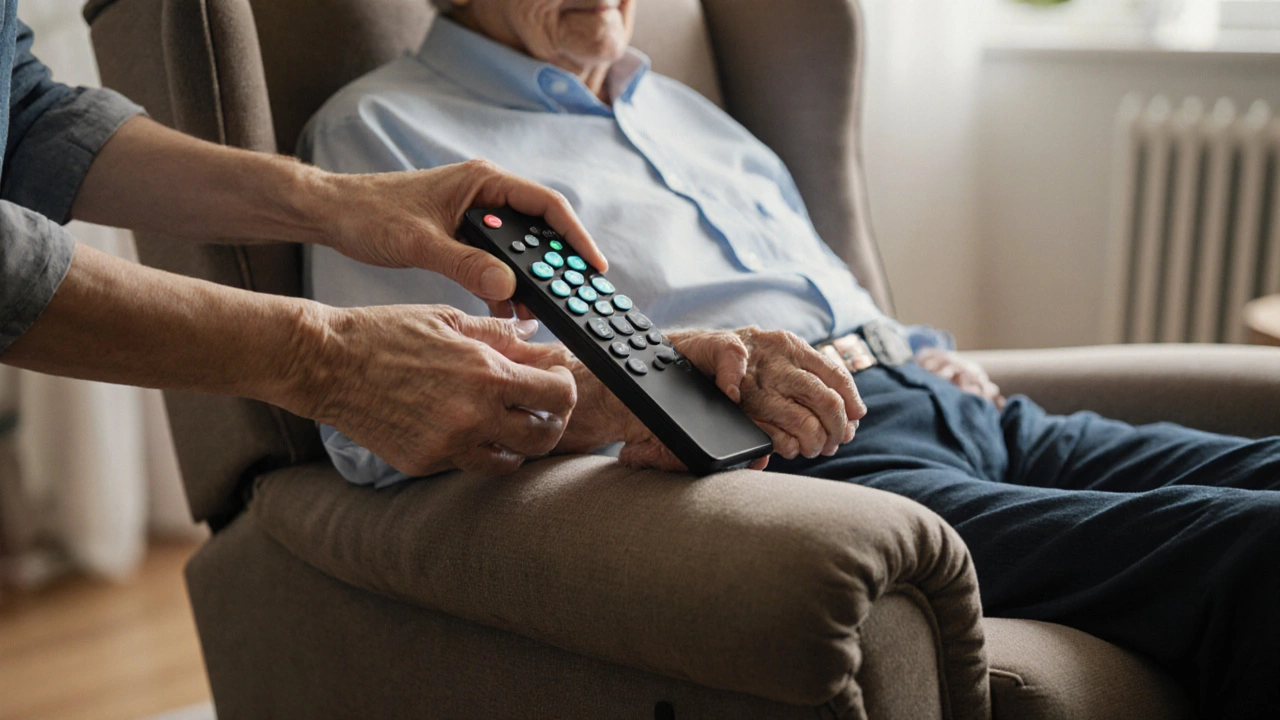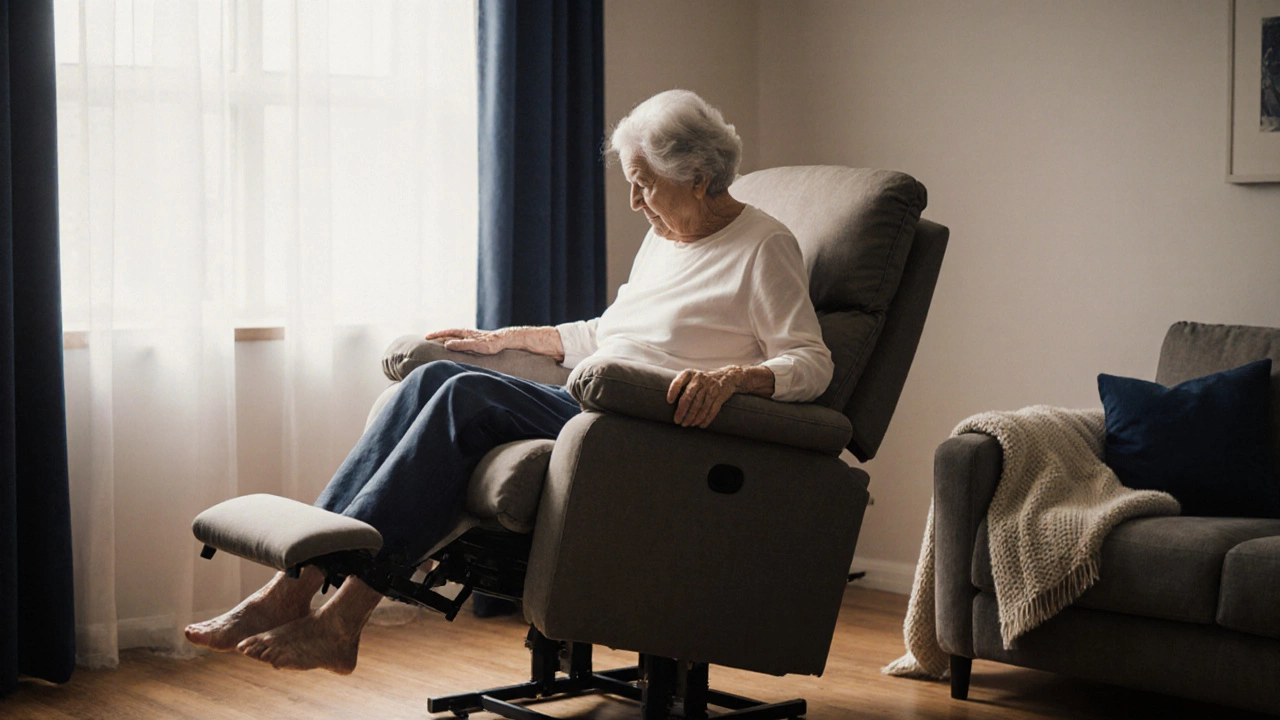Senior Recliner Feature Checker
Enter the specifications of the recliner you're considering to determine if it meets essential safety and comfort standards for seniors.
Recliner Evaluation
When you’re over 65, sitting down shouldn’t feel like a chore. Getting up from a low couch, bending to tie shoes, or staying seated for long periods can become painful or even risky. That’s where a senior recliner comes in - it’s not just another chair. It’s a support system designed for aging bodies, mobility challenges, and the need for real comfort.
What Makes a Recliner a ‘Senior’ Recliner?
A senior recliner isn’t just a recliner with a softer cushion. It’s built around specific needs: easier movement, better posture, pain relief, and safety. These chairs often include features you won’t find in standard recliners - like power lift mechanisms, heat and massage functions, extra-wide seats, and firm, supportive backing.
Unlike traditional recliners that require you to push back with your legs or use armrests to lift yourself up, senior recliners often have motorized lift systems. These gently raise the entire chair, helping users stand without straining their knees or hips. For someone with arthritis or recovering from hip surgery, that small lift can mean the difference between independence and needing help.
Many also have adjustable headrests, lumbar support, and padded armrests that are higher and wider - making it easier to push off without slipping. The upholstery is usually easy to clean, resistant to stains, and breathable to prevent overheating. Materials like microfiber or performance fabrics are common because they’re durable and don’t trap heat like leather can.
Why Do Seniors Need Special Recliners?
According to the CDC, over 80% of adults over 65 have at least one chronic condition - arthritis, back pain, heart disease, or poor circulation. Sitting in a regular chair for too long can make these worse. A standard recliner might let you lean back, but it doesn’t help you get up. That’s why senior-specific models are designed with movement in mind.
Studies from the American Physical Therapy Association show that power recliners with lift functions reduce fall risk by up to 40% in older adults. Falls are the leading cause of injury-related hospital visits for seniors. A chair that helps you rise smoothly isn’t a luxury - it’s a safety tool.
Also, many seniors experience swelling in the legs or poor blood flow. Recliners with adjustable footrests and zero-gravity positioning (where legs are elevated above the heart) can reduce swelling and ease pressure on the lower back. Some even have built-in compression zones that gently stimulate circulation.
Key Features to Look For
Not all senior recliners are the same. Here’s what actually matters when choosing one:
- Power lift mechanism - The most important feature. Look for models with smooth, quiet motors that lift the entire chair at a steady pace. Avoid ones that jerk or stop mid-motion.
- Weight capacity - Most standard recliners hold 250-300 lbs. Senior models often support 350-500 lbs. Check the specs before buying.
- Seat depth and width - A seat that’s too shallow won’t support your thighs. Look for at least 20 inches of depth and 22 inches of width. Extra-wide models (26+ inches) are ideal for larger frames.
- Lumbar and neck support - Adjustable lumbar cushions and headrests help maintain spinal alignment. Memory foam or high-density foam is better than cheap polyfill.
- Heat and massage - Not essential, but helpful for chronic pain. Look for targeted zones (lower back, thighs) rather than full-body vibration.
- Remote control - Should be large-button, backlit, and easy to hold. Some even have USB charging ports built in.
- Easy-clean fabric - Stain-resistant, wipeable materials like performance microfiber or vinyl are best. Avoid delicate fabrics like velvet or silk.
One common mistake people make is choosing based on looks alone. A sleek, modern recliner might look nice in a catalog, but if the armrests are too low or the seat is too soft, it won’t help in daily use. Stick to function over fashion.
Power vs. Manual Recliners
There are two main types: power and manual.
Power recliners use electricity to adjust the backrest, footrest, and lift function. They’re more expensive - usually $800 to $2,500 - but offer the most support. If mobility is limited, this is the only option worth considering.
Manual recliners rely on levers or push-back mechanisms. They’re cheaper ($300-$800) and don’t need power outlets. But they require more physical effort to operate. For someone with weak arms, shoulder pain, or limited hand strength, manual models can be frustrating or even unsafe.
If you’re unsure, test both types. Sit in a manual recliner and try to stand up without using your arms. If you have to push hard or lean forward awkwardly, it’s not the right fit.

Top Brands Trusted by Seniors
Not all brands are created equal. Here are the ones consistently recommended by occupational therapists and senior care advisors:
- La-Z-Boy - Known for durable frames and customizable options. Their Power Lift recliners are widely used in assisted living facilities.
- Home Decorators Collection - Offers budget-friendly power recliners with good support and a wide range of fabric choices.
- Catnapper - Focuses on comfort and cushioning. Their memory foam models are popular for people with back pain.
- Flexsteel - Built for longevity. Their steel frames and reinforced mechanisms last longer than most competitors.
- RelaxtheWorld - A newer brand with smart features like Bluetooth speakers, USB ports, and app-controlled settings.
These brands don’t just sell chairs - they offer warranties that cover motors, frames, and fabrics for 5-10 years. That’s a good sign they stand behind their products.
What to Avoid
Some features sound nice but can do more harm than good:
- Too-soft cushions - They may feel cozy at first, but they cause sinking and make standing harder. Firm support is better for posture.
- Low seat height - If the seat is lower than 19 inches, standing becomes a struggle. Aim for 20-22 inches.
- Small armrests - Thin or narrow arms won’t support your weight when pushing up. Look for arms that are at least 3 inches wide.
- No leg rest adjustment - Your legs should rest comfortably without dangling or being forced into an unnatural angle.
- Non-removable covers - Spills happen. If the cover can’t be taken off and washed, it’s not practical for long-term use.
Cost and Value
Senior recliners range from $500 to $3,000. The cheapest models often cut corners on motors, foam density, or frame strength. You’re not just buying a chair - you’re investing in daily comfort and safety.
A $1,200 power recliner with a 10-year warranty, 500-lb capacity, and heat/massage is a better value than a $700 chair that breaks after two years. Many Medicare Advantage plans or veteran benefits cover mobility aids like lift recliners - check with your provider. Some even offer rental programs if you’re unsure about a long-term commitment.

Where to Buy
You can find senior recliners online, in big-box stores, or through medical equipment suppliers. Online retailers like Amazon or Wayfair have wide selections but limited ability to test. Physical stores like Costco, Furniture Row, or local mobility aid shops let you sit and try them out.
If you’re buying for someone else - say, a parent recovering from surgery - visit a store together. Let them test the chair. Pay attention to how easily they can get in and out. Watch their posture. If they sigh with relief when they sit down, you’ve found the right one.
Real-Life Use Case
Marjorie, 78, from Brisbane, started using a La-Z-Boy Power Lift recliner after her knee replacement. Before, she needed help getting up from her old sofa. Now, she sits in her recliner to read, watch TV, and even takes short naps. She says the lift feature gave her back her mornings - she gets up on her own, makes coffee, and doesn’t wait for someone to help her.
Her daughter, who lives in another state, says the peace of mind was worth the cost. "I used to worry every time she sat down. Now I know she can get up safely. That’s not just comfort - that’s dignity."
Final Thoughts
A senior recliner isn’t about aging. It’s about staying active, independent, and comfortable. It’s not a medical device, but it performs like one - helping people move with less pain, sit with better posture, and rise without fear.
If you or someone you care about is struggling to get up from a chair, or sitting for long periods causes discomfort, a senior recliner isn’t a luxury. It’s a practical, life-changing upgrade. Don’t wait until mobility becomes a crisis. Start looking now - your body will thank you later.
What is the difference between a regular recliner and a senior recliner?
A regular recliner lets you lean back and sometimes raise your feet, but it doesn’t help you stand up. A senior recliner includes features like power lift mechanisms, higher seat height, wider armrests, and firmer cushioning designed specifically to help older adults move safely and comfortably. It’s built for mobility challenges, not just relaxation.
Can Medicare cover a senior recliner?
Original Medicare (Parts A and B) doesn’t cover recliners. However, some Medicare Advantage plans (Part C) may offer supplemental benefits that include mobility aids. If the recliner is prescribed by a doctor as a durable medical equipment (DME) item for conditions like arthritis or post-surgery recovery, there’s a chance it could be covered. Always check with your plan provider and get a written prescription.
How long do senior recliners last?
A well-made senior recliner with a solid steel frame and quality motor can last 10 to 15 years with regular use. Cheaper models may start showing wear after 3-5 years, especially if the motor or foam breaks down. Look for warranties that cover the frame, motor, and fabric - a 5-year or longer warranty is a good indicator of durability.
Are power recliners safe for seniors?
Yes, when used properly. Power recliners reduce the risk of falls by helping users stand without straining joints. Make sure the chair has safety features like automatic stop if it hits an obstacle, and a backup battery in case of power outage. Always follow the manufacturer’s instructions and keep the remote within easy reach.
Do senior recliners require a power outlet?
Most power recliners do need to be plugged in. However, some models come with a backup battery that allows you to return to the upright position during a power outage. Manual recliners don’t need electricity but require more physical effort to operate. If you’re concerned about power access, consider a battery-powered lift recliner or a manual model with high armrests.
What’s the best fabric for a senior recliner?
Performance microfiber is the top choice - it’s soft, stain-resistant, easy to clean with a damp cloth, and doesn’t trap heat. Vinyl is also durable and wipeable, though less breathable. Avoid delicate fabrics like silk, velvet, or linen, which stain easily and can’t be washed. For seniors who may have incontinence concerns, waterproof or moisture-resistant covers are a smart addition.
Can a senior recliner help with back pain?
Yes, especially if it has adjustable lumbar support and zero-gravity positioning. These features reduce pressure on the spine and promote natural alignment. Memory foam cushions and firm support also help prevent slouching, which is a common cause of chronic back pain in older adults. For best results, combine the chair with gentle stretching and regular movement.
When choosing a senior recliner, think beyond comfort. Think about safety, independence, and daily ease. The right chair doesn’t just sit in your living room - it helps you live better.

